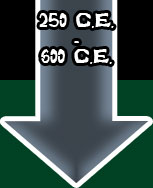

KOFUN PERIOD
The final early Japanese period was the protohistoric Kofun Period (250 C.E. - 600 C.E.). Kofun pottery can be divided into two categories: Haji and Sue. Haji ware came from finer, different kinds of minerals. Nonetheless, the aesthetic styles and usages of Haji ware were quite similar to that of the Yayoi pottery: large jars/pots for storage and cookings, high and low footed cups for eating, vessels to be used as cooking tools, and ritualistic/ceremonial jars. The second kind of Kofun pottery was Sue ware, a kind of stoneware that had been brought from Korea. The shape of Sue ware was determined by the use of the potter's wheel, and then fired in anagama, or single chamber climbing slots. Unlike its Jomon and Yayoi predecessors which were fired in pits, Kofun Sue ware was actually fired in kilns. Sue ware was close to if not identical to the original styles of Korean pottery, but while Korean pottery was more decorated, Sue ware followed the traditions of native Japanese pottery, being more simple. The Kofun period earns its name from the word kofun, meaning "old mound," since the most prominent characteristic of the period are the large tombs in which the wealthy were buried in. Although jars were no longer being used to store corpses (as the Jomon people did), pottery still played a ritualistic role in the period. Some Sue ware were decorated and placed in the large tombs. |
|
 |
 |
| SUE: This long-necked jar is from the Late Kofun period (600-700 C.E.) | SUE: This ash-glazed jar was made around 500-600 C.E. It depicts horses on its upper half, a characteristic quite common among vessels (see Haji jar below) from the period. |
|
 |
| HAJI: This vessel was made from clay, around 248-646 C.E. | HAJI: Another Late Kofun vessel with horses on it. |
<<Previous: YAYOI PERIOD | Next: KILNS>>






